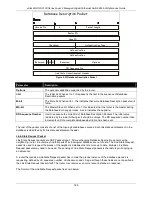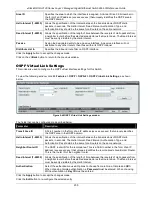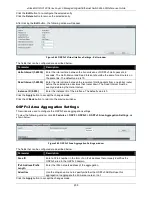
xStack® DGS-3120 Series Layer 3 Managed Gigabit Ethernet Switch Web UI Reference Guide
196
Type-7 LSA (Link State Advertisement) packets are
used to import external routes into the NSSA.
These packets can originate from NSSA ASBRs or
NSSA ABRs and are defined by setting the P-Bit in
the LSA type-7 packet header. Each destination
network learned from external routes is converted
into Type-7 LSA packets. These packets are
specific for NSSA switches and the route
information contained in these packets cannot leave
the area unless translated into Type-5 LSA packets
by Area Border Routers. See the following table for
a better description of the LSA type-7 packet seen
here.
Figure 5-43 LSA Type-7 Packet
Parameter
Description
Link State Packet
Header
This field will hold information concerning information regarding the LS Checksum,
length, LS sequence number, Advertising Router, Link State ID, LS age, the packet
type (Type-7), and the options field. The Options byte contains information regarding
the N-Bit and the P-Bit, which will be described later in this section.
Network Mask
The IP address mask for the advertised destination.
E-bit
The type of external metric. If the E-bit is set, the metric specified is a Type 2 external
metric. This means the metric is considered larger than any link state path. If the E-bit is
zero, the specified metric is a Type 1 external metric. This means that is comparable
directly to the link state metric.
Forwarding Address
Data traffic for the advertised destination will be forwarded to this address. If the
Forwarding Address is set to 0.0.0.0, data traffic will be forwarded instead to the
advertisement’s originator.
Yet, if the network between the NSSA ASBR and the adjacent AS is advertised in the
area as an internal OSFP route, this address will be the next hop address. Conversely,
if the network is not advertised as internal, this field should be any of the router’s active
OSPF interfaces.
TOS
The Type of Service that the following cost is relevant to.
Metric
The cost of this route. The interpretation of this metric depends on the external type
indication (the E-bit above).
External Route Tag
A 32-bit field attached to each external route. This is not used by the OSPF protocol
itself.
The N-Bit
Contained in the options field of the Link State Packet header, the N-Bit is used to ensure that all members of an
NSSA agree on the area configurations. Used in conjunction with the E-Bit, these two bits represent the flooding
capability of an external LSA. Because type-5 LSAs cannot be flooded into the NSSA, the N-Bit will contain
information for sending and receiving LSA type-7 packets, while the E-bit is to be cleared. An additional check must
be created for the function that accepts these packets to verify these two bits (N and E-Bit). Bits matching the
checking feature will be accepted, while other bit combinations will be dropped.
Summary of Contents for xStack DGS-3120 Series
Page 1: ......
















































